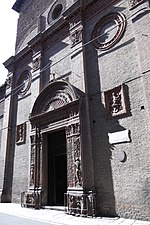Palazzo Legnani Pizzardo, Bologna
Houses completed in the 16th centuryPalaces in BolognaRenaissance architecture in Bologna

The Palazzo Legnani Pizzardi, also known as Palazzo Pizzardi e Volta or just Palazzo Pizzardi, is a Renaissance style palace located on Via d'Azeglio #38, corner with Via Farini, in central Bologna, Italy. In 2015, the palace housed the Tribunal of Bologna.
Excerpt from the Wikipedia article Palazzo Legnani Pizzardo, Bologna (License: CC BY-SA 3.0, Authors, Images).Palazzo Legnani Pizzardo, Bologna
Via Massimo D'Azeglio, Bologna Galvani
Geographical coordinates (GPS) Address Nearby Places Show on map
Geographical coordinates (GPS)
| Latitude | Longitude |
|---|---|
| N 44.491113888889 ° | E 11.341675 ° |
Address
Via Massimo D'Azeglio
Via Massimo D'Azeglio
40124 Bologna, Galvani
Emilia-Romagna, Italy
Open on Google Maps










